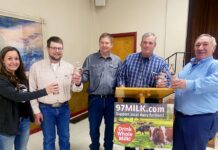Do you know how much milkfat is in whole milk? That’s a question many consumers can’t answer correctly, the 97 Milk campaign found.
When the Pennsylvania-based group informally surveyed consumers, they got answers ranging anywhere from 50 to 100% fat in whole milk.
“People go to store and look at milk and everything else has a percentage … You’d be surprised how many people thought it was 100% percent,” said Nelson Troutman, a dairy farmer, from Lebanon County, Pennsylvania, who helped found 97 Milk.
“That’s how uneducated the consumer is, and it’s not their fault.”
The answer is about 3.25% fat on average. Just a little over what is in 2% reduced fat milk. While skim milk, low fat and reduced fat milk have the milkfat percentage right on the label (fat free, 1% and 2%, respectively), whole milk doesn’t.
The misconception about whole milk may be preventing people from drinking it, Troutman said.
Rebranding opportunity
Consumers could see a small, but mighty change on their whole milk jugs after a memo by the Pennsylvania Department of Agriculture’s Bureau of Food Safety. At the behest of the state dairy industry, the bureau carefully studied the U.S. Food and Drug Administration’s requirements for milk labeling.
The memo, issued Feb. 14, gave some clarity around the regulations for whole milk labeling. Federal law requires accuracy, the memo stated.
That means whole milk can have a specific fat percentage listed as long as the processor would have the milkfat percentage evaluated and labeled accordingly.
The fat content in whole milk can range from 3.25% to 18%, but it’s usually on the lower end of the scale. If it has milkfat content over 18%, it is considered cream. Whole milk is called that because no fat is removed from it before processing. It’s whole.
So, for example, whole milk with 3.25% milkfat could be labeled as 3.25% fat whole milk.
The label, however, cannot make a claim that the milk is 97% fat free. The fat free claim can only be made by food that meets the definition of low-fat food.
Whole milk goodness
Why does this matter? Because whole milk tastes better, Troutman said. If people knew it only contained 3.25% fat, they may drink it instead of the bland low fat or fat free milks and then drink more milk overall, he posits.
Saturated fat, the type found primarily in milkfat, has long been associated with heart disease and high cholesterol. The American Heart Association recommends consuming low fat or fat free dairy for a heart-healthy diet. The Healthy, Hunger-Free Kids Act of 2010 took whole milk and 2% milk out of schools in an effort to reduce fat intake in school lunches.
But recent studies are walking back the health dangers of saturated fat, especially dairy fats. It may not be as bad as once believed.
“We’re not telling consumers what to buy, but giving them information about the milk,” Troutman said. “But until they taste it, we don’t win.”
Troutman began to get the word out in March 2019 about the whole milk using “bale boards” — plastic-wrapped round bales painted with messages — placed at busy intersections throughout his area. His efforts grew into a website, 97milk.com, and a formal group to advocate for more transparency on whole milk labels and more education for consumers. Bale boards and similar banners touting the benefits of whole milk have spread throughout the country.
There’s been other movement too to boost whole milk consumption. U.S. Rep. Glenn Thompson, R-PA, introduced the Whole Milk for Healthy Kids Act of 2019 to last year to allow schools to serve whole milk again. An online petition on change.org is advocating for the same thing. It’s nearly to its goal of 25,000 signatures.
Have a plan
Russell Redding, Pennsylvania’s secretary of agriculture, cautioned in a statement about the memo that just adding the number to the whole milk label isn’t enough. It could go awry if people don’t understand what it means.
“For generations, consumers have been trained to look for skim, 1%, 2% or whole,” he said in a statement. “A label change without a strong, sustained plan for educating the public could backfire if consumers don’t see whole milk and don’t understand the new 3% label.”
Processors interested in making label changes are encouraged to contact the state’s Bureau of Food Safety and Laboratory Services to make sure any changes don’t conflict with federal labeling regulations.
(Reporter Rachel Wagoner can be contacted at 800-837-3419 or rachel@farmanddairy.com.)












Ah, there’s no %18 milk. There’s not even %7 milk. That would be an upper limit for the fat content of what can be squeezed out of a cow. (Other animals can have much higher fat content, however.)